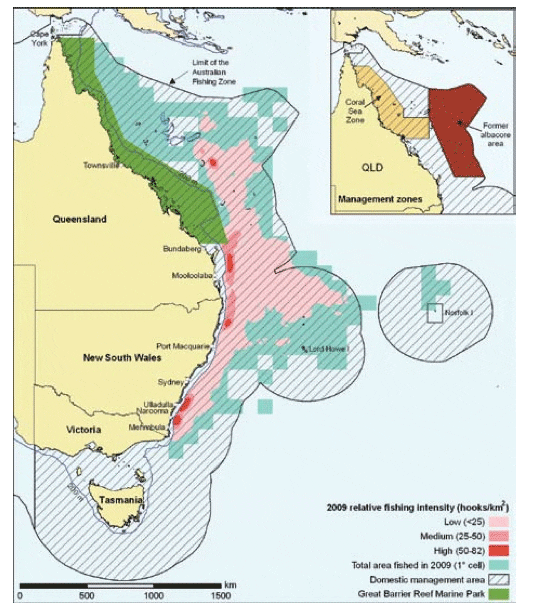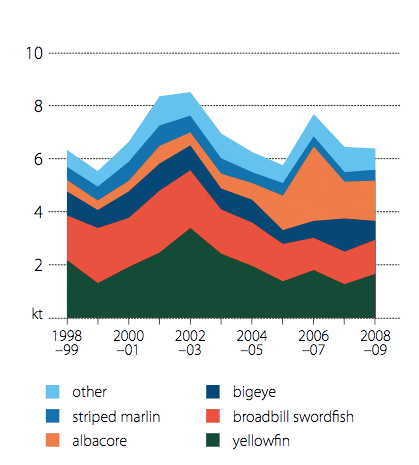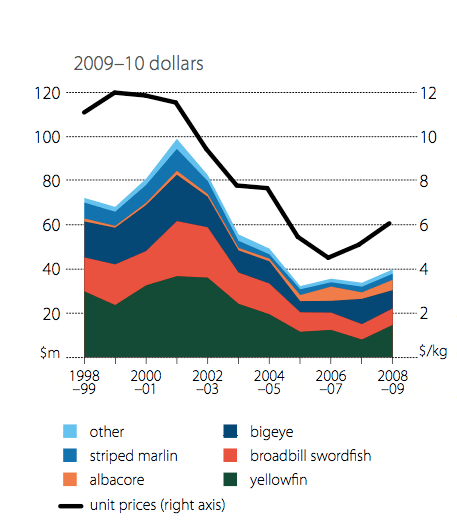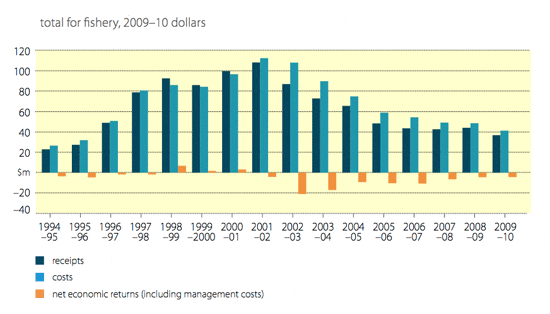The fishery
The fishery supports both commercial and recreational fishing activities. Commercial fishing occurs in a longline sector, which uses longline fishing methods, and a minor line sector in which rod-and-reel, handline and trolling methods are used. The longline sector accounts for the majority of the fishery’s catch (Wilson et al. 2010). The commercial longline sector can also be divided into boats that land catch in Queensland (the majority of boats being based in Mooloolaba) and those that land catch in New South Wales.
Key target species in the ETBF include yellowfin tuna, bigeye tuna, albacore tuna, broadbill swordfish and striped marlin. The current biological status of these species is not overfished and not subject to overfishing, with the exception of bigeye tuna and striped marlin. Bigeye tuna was most recently assessed as both overfished and subject to overfishing, while the status of striped marlin is uncertain (Wilson et al. 2010). The migratory nature of these species means that these stocks are shared internationally. The Western and Central Pacific Fisheries Commission (WCPFC) is the regional fisheries management organisation through which these stocks are jointly managed with other countries. Domestic management arrangements reflect Australia’s obligations to the WCPFC. The ETBF is currently going through a period of significant change. The Australian Government’s recent Securing Our Fishing Future structural adjustment package included a $149 million fishing concession buyback to allow individual fishing businesses to leave the industry. The ETBF was one of the fisheries targeted in this buyback. Concluding in December 2006, the buyback resulted in 45 per cent and 49 per cent reductions in longline and minor line permits, respectively (Vieira et al. 2010).
Following the buyback, a harvest strategy framework was developed for the fishery in response to a Ministerial Direction to AFMA to address and eliminate overfishing in Commonwealth fisheries. The framework is scheduled to be fully implemented in 2010. Interim management arrangements were introduced in November 2009 and currently apply. Under these arrangements, harvest levels are managed using a total allowable effort (TAE). The TAE is set using target-driven catch per unit effort rules and a ‘decision tree’ approach that uses a range of fishery indicators and associated reference levels. Together, these tools indicate a recommended biological catch for each target species and a corresponding TAE can then be determined (Wilson et al. 2010). These interim arrangements are planned to cease with the introduction of output-based management under individual transferrable quotas in 2011. For an in-depth overview of the fishery including its history, management arrangements, biological and economic status, see Wilson et al. (2010).
Location and relative fishing intensity, Eastern Tuna and Billfish Fishery, 2009

Catch and gross value of production
Historically, the combined catch of yellowfin tuna and billfish has comprised more than half of the fishery’s catch (figure a). However, since 2004–05 operators have increasingly targeted albacore tuna, thus altering the catch composition in the fishery. The production volume of albacore rose from 630 tonnes in 2004–05 to 2800 tonnes in 2006–07, but declined to 1520 tonnes in 2008–09.
Of the 6400 tonnes of fish landed in 2008–09, the combined weight of yellowfin tuna (26 per cent), albacore tuna (24 per cent) and broadbill swordfish (20 per cent) accounted for more than three- quarters of the catch. Key changes in 2008–09 were a 43 per cent drop in bigeye tuna landings and a 31 per cent increase in yellowfin tuna landings.
Although the total volume of production fell by only 1 per cent between 2007–08 and 2008–09, the fishery’s gross value of production (GVP) increased by 18.0 percent in real terms to $39.8 million (2009–10 dollars) (figure b). This is 60 per cent lower than the peak of $98.9 million recorded in 2001–02. An 83 per cent increase in the value of yellowfin tuna landings and a 60 per cent increase in the value of albacore landings, both in 2008–09, were key contributing factors. In the case of yellowfin tuna, this increase occurred with an increase in yellowfin tuna landings, together with a 40 per cent increase in real prices. Similarly, albacore prices increased by 45 per cent in real terms in 2008–09. Yellowfin tuna (37 per cent of GVP), bigeye tuna (21 per cent) and broadbill swordfish (19 per cent) were the key species in value terms in 2008–09.
Landed catch, Eastern Tuna and Billfish Fishery, longline and minor line

Real gross value of production and real unit prices, Eastern Tuna and Billfish Fishery, longline and minor line

Survey results
Boats surveyedThe 2010 survey collected data for the 2007–08 and 2008–09 financial years. The survey method used by ABARES is described in appendix B. The target population for the ETBF survey was defined as any longline boat that recorded catch in either of these two financial years. The minor line sector was excluded. There were 58 boats that recorded catch in the ETBF in 2007–08 and 55 in 2008–09. Out of this survey population, 24 boats were sampled in each year, which was a sample size of 41 per cent and 44 per cent of the population in 2007–08 and 2008–09, respectively. For the purpose of constructing estimates of financial and economic performance, the fishery population is divided into two fleet types: Queensland fleet and New South Wales fleet. A sampled boat only represents a non-sampled boat of the same fleet. The reason for this approach is that the operating characteristics of the two fleets are likely to differ. This is partly because of differences in the spatial characteristics and location of fishing activity between the two fleets. Additionally, most Queensland boats operate in vertically integrated business structures where fish harvesting activities are integrated with fish processing activities within the same business structure. The operating characteristics of these boats are likely to differ to other non-vertically integrated operators, particularly in terms of boat cost and revenue structures. Financial performance estimates could not be reported at the fleet level for confidentiality reasons.
Boat-level financial performanceSurvey-based estimates of average boat-level financial performance are presented in nominal terms in table 1. Financial performance estimates include the receipts and costs earned and incurred by boats in both the fishery being surveyed and any other fisheries that sampled boats may have operated in during the survey years. For the current ETBF survey, all operators surveyed indicated that they only operated in the ETBF during the survey period. Consequently, the receipts and costs displayed in table 1 relate only to the ETBF. Differences in financial performance that arise from specific fleet characteristics for Queensland and New South Wales boats are also noted where relevant. Definitions of items contained in table 1 are included in appendix A. Receipts Average seafood receipts per boat in the ETBF in nominal terms increased between 2007–08 and 2008–09 from $695 000 to $782 000. This represented an increase of 12 per cent.
Costs Total cash costs for the average boat in the ETBF also increased in 2008–09, but by marginally less than seafood receipts. Total cash costs were $702 000 a boat in 2007–08 and increased by 11 per cent to $781 000 a boat in 2008–09.
The key cost items in both years were crew costs (accounting for 29 per cent of total cash costs in 2008–09), fuel (14 per cent), repairs and maintenance (14 per cent) and freight and marketing (13 per cent). Together, these cost items accounted for 70 per cent of total cash costs for the average ETBF boat in 2008–09. Key changes between 2007–08 and 2008–09 were an 18 per cent increase in average crew costs per boat and a 13 per cent decline in fuel costs per boat. Given crew are generally paid a share of seafood receipts, the increase in crew costs was broadly consistent with the increase in fishing receipts. The decline in average fuel costs per boat reflects the fall in average fuel prices between the two years.
Boat cash income reflects the difference between total cash receipts and total cash costs per boat. For the average ETBF boat, boat cash income increased from $9000 to $14 000 between 2007–08 and 2008–09, which was an increase of 64 per cent. Boat business profit, which is boat cash income less depreciation, for the average boat in the ETBF remained negative over the two years, although it did improve from –$41 000 in 2007–08 to –$31 000 in 2008–09. Profit at full equity, which is boat business profit plus interest, leasing and rent, increased from –$12 000 a boat in 2007–08 to –$2000 a boat in 2008–09. This profit measure is calculated by removing all costs associated with interest, leasing and rent to treat these items as transfers to other entities rather than costs. While these items impose a cost on the operator, they represent profits that have been redistributed to other investors in the fishery. As such, profit at full equity represents the average return to the business unit had the boat and capital (including quota and licences) been fully owned by the operator.
Rates of returnThe rate of return to boat capital, excluding the value of quota and licences, for the average ETBF boat improved substantially between survey years from –2.0 per cent a boat in 2007–08 to –0.4 per cent a boat in 2008–09. To allow the financial performance of all boats to be compared irrespective of the operators’ equity in the business unit, rates of return are calculated assuming all capital assets are owned by the operator. The rate of return to full equity includes the value of quota and licences in addition to other capital, and therefore provides an indication of the return to total capital invested in the business unit. It reflects changes in the value of capital, quota and licences, as well as changes in boat-level profitability. The rate of return to full equity for the average boat in the ETBF increased from –1.1 per cent a boat in 2007–08 to –0.2 per cent in 2008–09.
Fishery-level economic performance The boat-level estimates displayed in table 1 indicate the financial performance of the average boat in the ETBF in 2007–08 and 2008–09. However, the measure presented is not an accurate indicator of fishery-level economic performance as it excludes some key economic costs. Table 2 presents historical receipts, costs and key measures of fishery-level profitability; namely, boat cash profit and net economic return, in real terms. Boat cash profit measures the difference between cash receipts and cash costs in a fishery. As such, it reveals the cash position of the fishery. Net economic return, in comparison, reveals economic profitability, as it incorporates depreciation costs and the opportunity cost of capital and labour and it treats all interest and leasing expenditure as an economic return to external investors in the fishery. Furthermore, it includes the total amount spent on managing the fishery, rather than just the management fees recovered from operators. A more detailed explanation of net economic return is included in appendix A. In real terms, fishing income peaked in 2001–02 at $108.1 million (2009–10 dollars) then declined until 2005–06, reflecting falls in catches that can be linked to stock level reductions (particularly for swordfish), declining fish prices and a 35 per cent fall in the number of boats operating in the fishery. In the three years since 2005–06, fishing income has remained relatively stable at slightly more than $40 million. Operating costs also peaked in 2001–02 at $96.7 million and has also declined since then. However, the rate of decline was slower relative to fishing income. As a result, boat cash profit declined from $17.8 million in 2000–01 to become negative for the first time in 2002–03 at –$5.2 million—the lowest reported boat cash profit since 1993–94. Boat cash profit has recovered incrementally in the years since, although it remained negative until 2006–07 (figure c).In the three years since 2005–06, while fishing income remained relatively stable, operating costs continued to decline (mainly reflecting declines in boat numbers). In the two survey years, 2007–08 and 2008–09, operating costs were $40.5 million and $41 million, respectively, while fishing income increased from $42.6 million to $44 million (an increase of 3 per cent) over the same period. As a result, boat cash profit continued to recover, becoming positive in 2007–08 at $2.0 million and increasing further in 2008–09 to $3.0 million. With the inclusion of non-cash costs and the removal of interest, leasing and management fees (see appendix A for explanation), net economic returns (excluding management costs) have also recovered since 2002–03. The rate of recovery in net economic returns has been greater relative to boat cash profit, given the decline in boat numbers in the fishery and, consequently, non-cash costs (especially capital-related costs—the opportunity cost of capital and depreciation).
Net economic returns (excluding management costs) increased from –$7.5 million in 2006–07 to –$3.3 million in 2007–08. The recovery continued in 2008–09, with net economic returns increasing to –$1.5 million. However, with the inclusion of management costs, net economic returns remained substantially negative in 2008–09 at –$4.5 million (figure c). While economic performance as measured by net economic returns is improving in the ETBF, returns still remain negative and have been since 2002–03. Positive boat cash profit provides some explanation as to why boats continue to operate in the fishery. Additionally, the Queensland fleet that dominates the fishery in terms of both boat numbers and catch mainly comprises boats that operate in vertically integrated business structures whereby harvesting, processing and exporting is all undertaken within one entity. As a result, there may be some transfer of economic rents from harvesting to post-harvesting operations within these vertically integrated entities.
Factors outside the control of fishery management affect both net economic returns and other measures of financial performance in the sector. For example, movements of the Australian dollar affect the prices received by fishers as well as the prices of some fishery inputs, such as fuel. More generally, the price of inputs such as fuel and gear are not controlled by fishery managers. However, the fishery manager may alter management settings to allow net economic returns to be maximised given prevailing input and output prices. This may require periodic review of the optimal level of catch and effort in the fishery to ensure stocks are maintained at profitable levels.
Boat cash profit and net economic returns, total for the Eastern Tuna and Billfish Fishery

Preliminary estimates of economic performance
Non-survey–based estimates of net economic returns for 2009–10 in real terms are presented in table 3, together with survey-based estimates for 2008–09 for comparison. The break-up of revenues and costs in table 3 differs to that in table 2 because of the different approaches taken to estimating the individual cost components in each table. The approach taken to estimating 2009–10 non-survey–based estimates for the ETBF is described in appendix C. Summary statistics for the 2009–10 preliminary estimates for the ETBF are provided in appendix D. At the fishery level, declines in both catch and average unit prices in 2009–10 are estimated to have resulted in a 16 per cent decline in real cash receipts, from $44.0 million in 2008–09 to $36.8 million in 2009–10 (2009–10 dollars). Key changes in cost items in 2009–10 in real terms were a $2.7 million (21 per cent) decline in labour costs, a $1.5 million (24 per cent) decline in fuel costs and a $1.3 million (22 per cent) decline in repairs and maintenance costs. The decrease in labour costs is consistent with the estimated decline in cash receipts, given that crew are generally paid a share of cash receipts. The decrease in fuel costs is because of declines in effort (in terms of distance travelled by boats) and average fuel prices (table 3). Overall, total adjusted operating costs are expected to have declined by $8 million (12 per cent), from $41.6 million in 2008–09 to $33.6 million in 2009–10.
| Preliminary non-survey–based estimates of net economic returns for the Eastern Tuna and Billfish Fishery in 2009–10 | ||||
|---|---|---|---|---|
| Fishery level | 2008–09 | 2009–10 | percentage change | |
| Cash receipts | $m | 44.0 | 36.8 | -16% |
| less Operating costs | ||||
| – Fuel | $m | 6.3 | 4.8 | -24% |
| – Labour | $m | 12.8 | 10.1 | -21% |
| – Repairs and maintenance | $m | 6.0 | 4.7 | -22% |
| – Other material costs a | $m | 3.6 | 3.3 | -9% |
| – Other service costs b | $m | 12.9 | 10.7 | -17% |
| Total adjusted operating costs b | $m | 41.6 | 33.6 | -19% |
| less Capital costs | ||||
| – Opportunity cost of capital | $m | 1.5 | 1.9 | 23% |
| – Depreciation | $m | 2.4 | 3.0 | 25% |
| Net economic returns | $m | -1.5 | -1.6 | -7% |
| Management costs c | $m | 3.0 | 2.8 | -8% |
| Net economic returns (incl. management costs) | $m | -4.5 | -4.4 | -3% |
| Boat level | ||||
| Population (no. of boats) | no. | 55 | 54 | -2% |
| Net economic return per boat (excl. management costs) | $ | –27000 | –30000 | -9% |
| Net economic return per boat | $ | –82000 | –81000 | 1% |
|
a) Excludes fuel and repairs and maintenance costs that are normally included in materials costs.
b Excludes interest, leasing and management fees. c Management costs for 2009–10 are based on budgeted figures provided by AFMA. |
||||
After the deduction of capital costs, real net economic returns (excluding management costs) are expected to have remained relatively stable, at –$1.5 million in 2008–09 and –$1.6 million in 2009–10. Since management costs are estimated to have fallen by 8 per cent in 2009–10 to $2.8 million, the ETBF has benefited from a slight improvement in net economic returns (including management costs), from –$4.5 million in 2008–09 to –$4.4 million in 2009–10. At the boat level, the exit of a single boat from the population means that, in percentage terms, net economic returns increased proportionally more at the fishery level (3 per cent) than it did at the boat level (1 per cent). In 2009–10, net economic returns (including management costs) were –$81 000 a boat. Figure d shows receipts, costs and net economic returns for all survey years, together with the non-survey–based estimates for 2009–10. More detail on the drivers of changes in historical economic performance in this fishery is provided in Wilson et al. 2010.
| Key drivers of change in net economic returns in the Eastern Tuna and Billfish Fishery, 2008–09 and 2009–10 | |||
|---|---|---|---|
| 2008 - 09 | 2009 - 10 | Variable Percentage Change | |
| Active boat numbers | 55 | 54 | -2% |
| Total catch (tonnes) a | 6399 | 5707 | -11% |
| Average catch price per kilogram b | $6.22 | $5.28 | -15% |
| Distance travelled per boat proxy (kilometres) c | 28165 | 18984 | -33% |
| Diesel fuel price per litre | $1.26 | $1.11 | -12% |
|
a) Total catch based on CDR data supplied by AFMA.
b) Average price per kilogram for 2008–09 is as presented in Australian Fisheries Statistics 2009 and based on ABARES estimates for 2009–10. c) Distance travelled applies only to boats previously sampled by ABARES, is approximate and is based on ABARES calculations. Note: All 2009–10 estimates are preliminary. Prices are in real terms (2009–10 dollars). Catch data based on catch disposal record data. |
|||
Real revenue, costs and net economic returns in the Eastern Tuna and Billfish Fishery

Further Reading
| - | You can view the full report by clicking here. |

